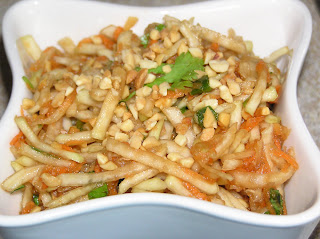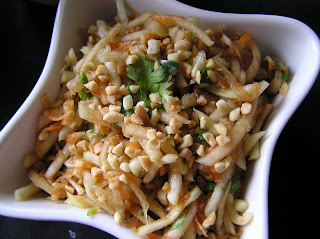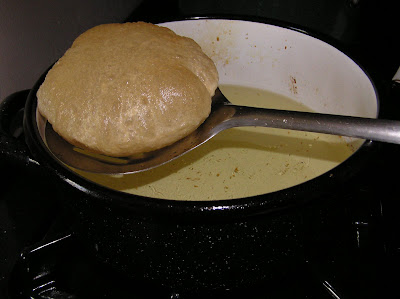
One Ingredient-Three recipes
Green Papaya ! Now I have this never ending love with this tropical fruit. I love it raw and ripe. See all the info on this fruit here and here. I have tried to make these three different recipes from one green papaya.
First one is the Korean Kimchi:
Kimchi is nothing but fermented vegetable pickles. There is no oil in it so it's virtually fat free and loaded with key vitamins.
Kimchi contains healthy bacteria that aids digestion.
 More of the health benefits of Kimchi here
More of the health benefits of Kimchi here Watch this video on Kimchi.
You can make Kimchi with any vegetables you like. Mostly it's made with Napa Cabbage, Daikon Radish, Cucumbers, Green onions. And I thought why not papaya, as it's a very underrated fruit. This was one good experiment, not only the Kimchi tasted good, but I found a new way to use the green papaya now.
I got the inspiration for Kimchi from here
Mine is a vegetarian kimchi. But traditional kimchi has fish sauce in it. I read it somewhere that do not use the Korean Fish sauce, instead use the Thai fish sauce which can be used in more then one dishes and has more flavor, where as Korean fish sauce is used just for kimchi.

I am using the old (cleaned) pickle jar. Yes I save all the pickle jars to reuse them. (my cheapness prevails). Isn't that another way of recycling!!

Now to the other recipe:
It is called Filipino Atchar, (pickled unripe papaya) sounds like Achaar but it is quite different then Achaar.
I saw this recipe long back on Internet.
This is a sweet pickle with invariably good taste. It could be more tasty with the coconut water vinegar, but it's hard to find here.
This is a sweet pickle with invariably good taste. It could be more tasty with the coconut water vinegar, but it's hard to find here.
Ingredients:
1/2 cup coarse salt
1 cup vinegar
2 carrots, thinly sliced
1/2 green bell pepper, thinly sliced (optional)
1/2 red bell pepper, thinly sliced (optional)
1 small ginger, cut into strips
5 cloves garlic, thinly sliced
1/4 onion, thinly sliced
Pickling mixture:1 cup vinegar, 3/4 cup sugar, 1 tsp. salt
Directions:
Boil the pickling mixture, stirring constantly until sugar is dissolved. Set aside and let it cool.
Combine grated papaya and salt. Knead together for a few minutes.
Put the papaya in a towel and squeeze out moisture. Soak grated papaya in vinegar overnight. Squeeze out as much vinegar from the papaya.
Combine with the other ingredients. Pack in sterilized jars and pour hot pickling mixture over the vegetables. Let cool at room temperature. Cover jars tightly and refrigerate.
Directions:
Boil the pickling mixture, stirring constantly until sugar is dissolved. Set aside and let it cool.
Combine grated papaya and salt. Knead together for a few minutes.
Put the papaya in a towel and squeeze out moisture. Soak grated papaya in vinegar overnight. Squeeze out as much vinegar from the papaya.
Combine with the other ingredients. Pack in sterilized jars and pour hot pickling mixture over the vegetables. Let cool at room temperature. Cover jars tightly and refrigerate.
You can add or omit ingredients as per your liking.
Now to the third recipe:
Thai Green Papaya salad also known as Som Tum.
Thai Green Papaya salad is a robust, healthy salad with additions of peanuts, and Thai basil.
Non-vegetarian version has dried shrimp and fish sauce in it.
Watch the video to see the recipe step by step.
Again you can add or omit ingredients as per your taste.
I did not put tomatoes, green beans or fish sauce in my salad and I used Serrano chilies
Ingredients
2 cups Green papaya (shredded)
5-6 cloves Garlic
Salt to taste
5-6 Fresh green-red chillies (roughly chopped)
4 Cherry tomatoes (quartered)
2 tbsp Lemon juice
2 tbsp Brown sugar or palm sugar (jaggery) or regular white sugar
1-2 tbsp Fish sauce or anchovy sauce
2 tbsp Roasted peanuts (crushed)
Peel and halve the papaya. Remove the seeds and grate coarsely. Transfer this into a big bowl and crush lightly with a pestle.Take garlic cloves and salt in a mortar and crush with a pestle. Add four fresh green-red chillies and cherry tomatoes and continue to crush.Add the crushed garlic mixture to the papaya along with lemon juice and mix.Take brown sugar in the mortar along with fish sauce and tamarind pulp and pound lightly with the pestle. Add this mixture to the papaya mixture and mix. Add crushed roasted peanuts and mix.







 Make a dough of your preferred consistency by mixing flour, salt, 1 tsp oil and water.
Make a dough of your preferred consistency by mixing flour, salt, 1 tsp oil and water.
















 One more lassi with a really cool and refreshing taste.
One more lassi with a really cool and refreshing taste.











